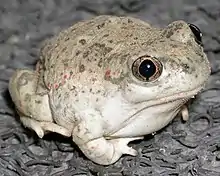New Mexico spadefoot toad
The New Mexico spadefoot toad (Spea multiplicata) is a species of American spadefoot toad found in the southwestern United States and Mexico. Like other species of spadefoot toad, they get their name from a distinctive spade-like projections on their hind legs, which enable them to dig in sandy soils. Spea multiplicata can be identified by its wedge-shaped spade. Some sources also refer to the species as the Mexican spadefoot toad, desert spadefoot toad or southern spadefoot toad.
| New Mexico spadefoot toad | |
|---|---|
 | |
| Scientific classification | |
| Domain: | Eukaryota |
| Kingdom: | Animalia |
| Phylum: | Chordata |
| Class: | Amphibia |
| Order: | Anura |
| Family: | Scaphiopodidae |
| Genus: | Spea |
| Species: | S. multiplicata |
| Binomial name | |
| Spea multiplicata (Cope, 1863) | |
| Synonyms | |
|
Scaphiopus multiplicatus Cope, 1863 | |
Description
The New Mexico spadefoot toad has a length of 1.5 to 2.5 inches (3.8 to 6.4 cm) with a round body and relatively short legs. They weigh between 1.7 and 3.5 ounces (48 and 99 g).[2] They are green, to grey, to brown, usually reflecting the soil color of their native habitat, often with black and orange colored speckling on their back, and a white underside. They have large eyes, with vertical pupils.
Behavior
Like all species of spadefoot toad, the New Mexico spadefoot toad is nocturnal and secretive. If handled, these frogs might emit a peanut like odor, which can cause tearing and nasal discharge if in close contact with the face. Spending most of its time buried in the ground, the spadefoot emerges during periods of summer rainfall to feed on insects and to breed. Breeding takes place in temporary pools left by the rain. Eggs laid in large masses, often hatch in as little as 48 hours. Females prefer to breed with sympatric males to produce hybrid tadpoles that can develop even faster.[3] The tadpoles are forced to metamorphose quickly, before the water dries up. This process can be as quick as 8 days after hatching. S. multiplicata tadpoles exhibit phenotypic plasticity. In most cases the tadpoles will exhibit diet traits of omnivores, feeding on detritus and plankton. Tadpoles that ingest fairy shrimp, when present, may express a novel carnivore phenotype. Features of this carnivore phenotype include enlarged jaw muscles and mouthparts that can aid in capturing and consuming prey.[3] This novel phenotype increases the rate of development, helping the tadpoles to escape drying pools more rapidly.[4]
Taxonomy
The species was once classified as a subspecies of the western spadefoot toad, Spea hammondii, but distinctive morphological characteristics led researchers to reclassify it as its own species. The New Mexico spadefoot toad is also known to hybridize with the Plains spadefoot toad, Spea bombifrons in the areas where their ranges overlap, making distinguishing the species from each other difficult.
Trivia
- The New Mexico spadefoot toad was designated as the official State Amphibian of New Mexico in 2003.
References
- IUCN SSC Amphibian Specialist Group (2022). "Spea multiplicata". IUCN Red List of Threatened Species. 2022: e.T59047A53972984. doi:10.2305/IUCN.UK.2022-1.RLTS.T59047A53972984.en. Retrieved 12 May 2023.
- "New Mexico Spadefoot Toad". Pajarito Environmental Education Center. Retrieved 2023-09-25.
- Seidl, Fabian (2019-10-02). "Genome of Spea multiplicata, a Rapidly Developing, Phenotypically Plastic, and Desert-Adapted Spadefoot Toad". National Library of Medicine. 9: 1 – via G3 (Bethesda).
- Pfennig, David (1990). "The adaptive significance of an environmentally-cued developmental switch in an anuran tadpole". Oecologia. 85: 101–107. doi:10.1007/bf00317349.
- Herps of Texas: Spea multiplicata
- Amphibian Species of the World: Spea multiplicata
- Peterson Field Guide - Western Reptiles and Amphibians 3rd Edition
External links
 Media related to Spea multiplicata (New Mexico spadefoot toad) at Wikimedia Commons
Media related to Spea multiplicata (New Mexico spadefoot toad) at Wikimedia Commons Data related to Spea multiplicata at Wikispecies
Data related to Spea multiplicata at Wikispecies
